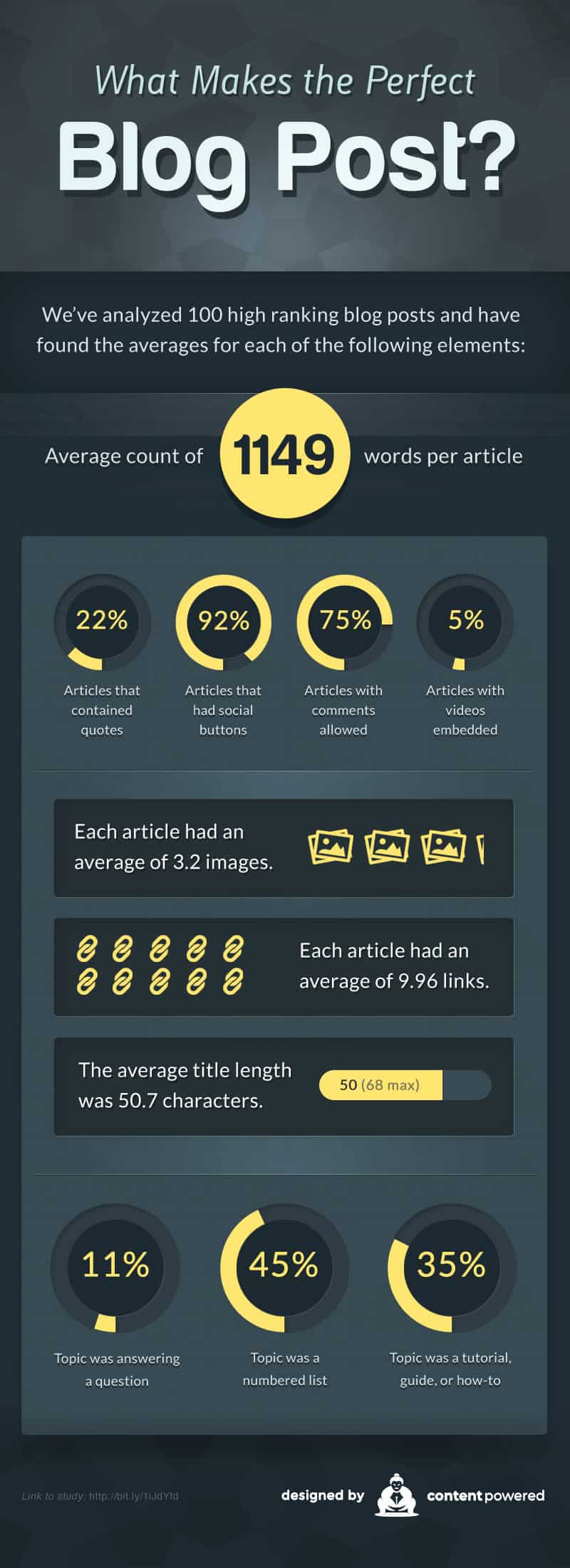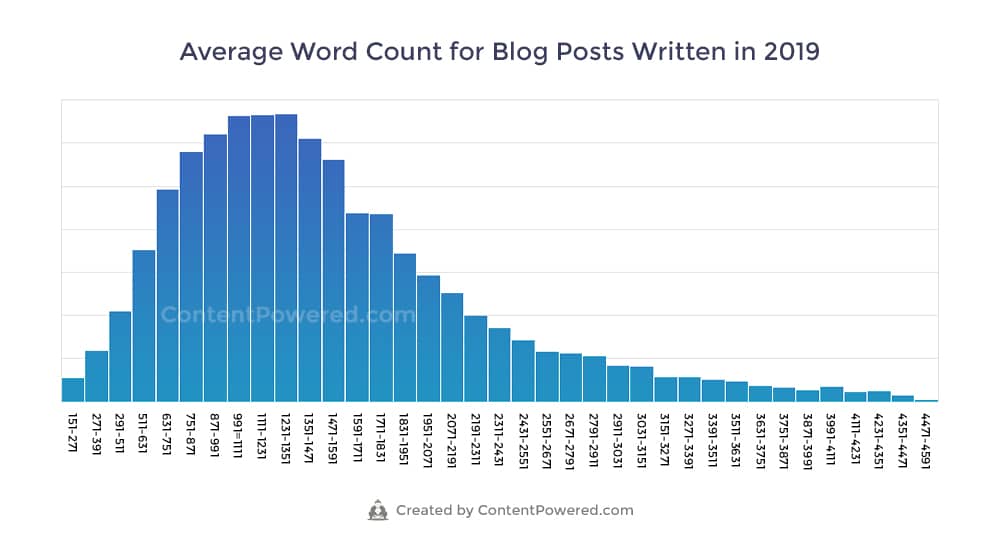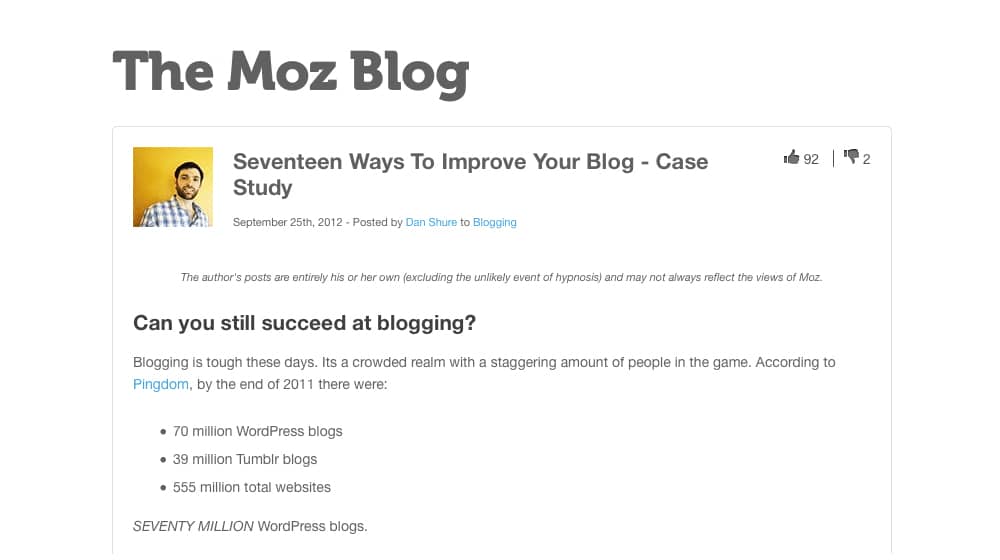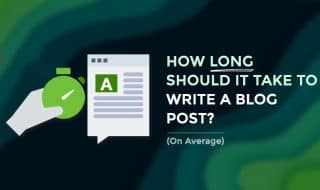What Makes The Perfect Blog Post [Infographic]

Embed in Your Article
This code links back to contentpowered.com
Always interested in what goes into the best content we can publish, we recently performed an analysis of 100 top blog posts across a number of popular sites, including Forbes, Mashable, KISSMetrics and SearchEngineWatch. The data speaks for itself, but the conclusions are up to you. What do you see in the data? Here's what we think.
 30 Second Summary
30 Second Summary
An analysis of 100 top blog posts reveals longer articles, averaging 2,000 words, perform better in shares and engagement. High-quality, in-depth content that addresses user needs ranks well without filler or excessive length. The ideal post length varies from 1,500 to 2,500 words depending on the topic's complexity and business goals. Additional findings include a standard use of images and social sharing buttons, while videos remain uncommon. Titles average 50 characters, with a trend towards informative guides and numbered lists. The study suggests focusing on valuable content tailored to the audience over hitting a specific word count.
What's New in 2024?
A lot has changed in the blog and SEO world since we first created this study in 2014, and especially in the last couple of years.
Looking at the state of content creation in 2024, especially in blogging, there's a constant shift toward thorough, long-form posts. In the old days (around ten years ago), the classic "Google-worthy" blog post averaged around 1,000 words.
Nowadays, though, things aren't so simple; the goalposts have moved even further away. The real MVPs in the content strategy game are in-depth and comprehensive blogs. Ten years ago, it was 1,000 words, then 1,300, then 1,500, now it's closer to 2,000. We're starting to see a pattern.
Here's a look at the average word count of posts written between 2011 and 2015: 
Then, compare it to this graph from my research study a few years ago on average word counts:

Do you see the gradual shift towards an increase in content length? That hasn't slowed down!
According to the number-crunching and data analysis I've seen, blogs with a higher word count of up to 7,000 words get over triple the shares and links compared to the short and sweet options. So, really sinking your teeth into a topic is great for reader engagement and adds extra worth to your work.
Anecdotally, with some data from my past research studies and experience with clients, the "just right" length for blog posts bounces between 1,500 and 2,500 words, and hitting this sweet spot provides depth without going to overkill on your word count. The important thing is that you create human-friendly content that helps people, not creating a boring encyclopedia wall of text. Here's a look at a pic from my research study a few years ago on average word counts:
While word count isn't everything, it's still an important factor. How much value can you really cram into a 500-word blog post on something? Not much, right? What about 2,500? Much better chances that the longer post is going to be more helpful. Search engines usually see it this way, too. Keyword usually - this is topic dependant. Some topics don't need a giant article to answer a simple question. If I Google "what is the capital of Washington?", the #1 page is 339 words. But that makes sense. What about a search for a "beginner's guide to welding"? This is a much tougher topic, and you'll see longer guides with a higher word count. The topic matters quite a bit.
So, blog posts that are around 2,000 to 3,000 words tend to correlate to better rankings, but even Google says not to shoot for a target word count. Focus on satisfying the user and providing helpful content, not hitting word count goals. That's straight from Google, and it's good advice.
But here's the kicker: all these numbers are flexible. What I might think about the "perfect" blog post length might change based on things like your business area, how complicated your topic is, and what you're hoping to accomplish with your content.
The core guide to remember is this: always choose quality over quantity! In 2024, we're seeing a higher number of longer, thorough guides because they are typically more in-depth and helpful. Thorough guides meet what the reader is looking for and give you informative, valuable insights without packing in unnecessary fillers.
The fact that better quality content is still a factor in 2024 isn't surprising. Google's only been recommending this for, oh, I don't decades?
The "ideal" blog post length is flexible, but a well-crafted post bouncing around 1,500 to 2,500 words (or maybe even more) seems to be a good balance between length and speed without getting too carried away and experiencing diminishing returns.
We create blog content that converts - not just for ourselves, but for our clients, too.
We pick blog topics like hedge funds pick stocks. Then, we create articles that are 10x better to earn the top spot.
Content marketing has two ingredients - content and marketing. We've earned our black belts in both.
What do you think, and what's been your magic number for word count? Let me know in the comments!
#1: Length
An average length of a hair over 1,000 words is fairly standard for the industry. The longest we examined, a case study by Moz, packed every paragraph with data and advice. The shortest tended to be quick, short bursts of useful advice. Some were hubs for links to other useful posts, kept up to date with fresh content.

#2: Content
Quotes were present in nearly a quarter of the posts we viewed, though some were as simple as a proverb to set the tone for the post. Social sharing buttons were by far the norm, with only a few barebones site layouts ignoring that blogging convention. Comments are enabled on three quarters of the posts. Those that don't tended to be more focused on the call to action than the value of the content itself.
#3: Video
Embedding a video was rare throughout these posts. Of the five, four were hosted on YouTube, with the fifth residing on Vimeo. Three were explanations of concepts that went along with the content, while one was an example used to prove a point and the fifth was a tutorial.
#4: Images
Graphics are standard throughout blogging, with only 16 percent of posts containing no images at all. Most of the posts without images came from Forbes or About.com, both of which emphasize an austere look to their sites. Of the rest, often the site layout included plenty of graphics already, so images in the post itself would be cluttered.

#6: Links
Links are an interestingly skewed statistic. Some of the smaller posts had incredibly high link-per-word ratios, owing to the fact that they were essentially tables of contents for other resources. Eight posts lacked links in the content of the blog, though they often included a final sentence call to action or related content widget.
#7: Titles
A length of 50 characters is plenty for most blogs, with none straying over 85. The longest tended to have secondary titles in parentheses, for added emphasis. The shortest? The simple and appropriately titled "Content Marketing."
#8: Topics
Eleven posts answered questions directly posed by the title. 45 posts included numbered lists, which are a popular and powerful way to distribute advice and resources. 35 were guides, none of which overlapped with those eleven answering questions.
Interesting Questions and Implications
Are videos often used as tutorials? In this case, only one out of a hundred posts used a video tutorial, and it was a supplement to the image-heavy text tutorial explaining the same thing. Video seems better utilized as supplementary content or as an example to prove a point.
Are images generally used for flavor or for instruction? Numbered lists often used images to illustrate each point, be it a screenshot of an app for each, a graphic that fit the theme or a semi-related image. Posts with few images tended to use one graphic with the title, or an infographic partway through. The most image-heavy posts – the Moz case study, the WikiHow tutorial and a Forbes poll of industry leaders – used images in tight conjunction with the text. The most image-dense posts – that is, those with a high image per word ratio – generally used images to show an example of each point in a list. The most image-dense of all was a numbered list of infographics, letting the graphics speak for themselves.
For the few posts without social sharing buttons, how do they promote sharing their content? Several of the posts relied on site-wide social networking buttons, which linked to the site profiles but didn't automatically share the individual post.
What about link density? Some popular posts included no links at all, while others were virtually entirely links. Link density – as long as those links provide value, as in the resource posts – seemed not to affect performance of the post at all.
With the raw data in hand, what conclusions can you draw? How do your popular blog posts compare? Please let me know in the comments below!



 30 Second Summary
30 Second Summary


Comments